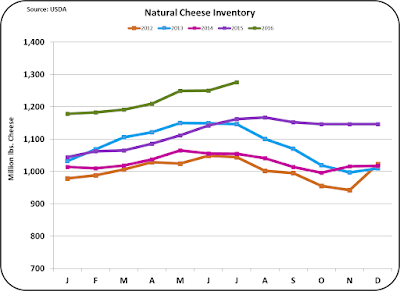Milk protein showed a tremendous increase of 34.7% due to the increase in cheese prices and lower butter price.
The pie chart of the component makeup of the milk check is shown below. In July, milk protein made up just 37% of the milk check. In August, this increased to 46% and further increases in the value of milk protein can be expected as global butter markets equalize with U.S. butter prices declining .
In the last month, there have been numerous new articles on reduced milk production in Oceania and the U.S. Additionally the USDA announced a program to buy excess cheese and reduce inventories. While this news is positive and has brought higher prices in August, will these prices hold and perhaps continue to increase? As forecast by the futures market, Class III milk prices will linger in the $16/cwt. area, which is above 2015 and 2016 YTD price, but well below the 2014 highs of $24/cwt.
CHEESE
The most important parameter for milk prices is the price of cheese. The price of cheese is strongly influenced by the cheese inventory levels. Unfortunately, cheese production continues to increase and cheese inventories, as shown below, continue to build.
The USDA purchase of cheese as announced was for the purchase of 11 million pounds of cheese. The excess between inventories at this time last year and the current level is about 110 million pounds of cheese. That means that the USDA purchase of cheese is about 10% of the "excess" inventory. The reality is that the purchase provides only a small dent in the excess inventories. That really leaves the increase in cheese price (up 10.4%) as largely an emotional response, not based in firm analytics.
Production of cheese remains robust. The current level of production does not seem to recognize the decreased exports and increased imports of cheese. The best rationale for the continued high production is that cheese does represent a good parking spot for excess milk production.
The August NASS price for cheese was $1.81/lb. The futures prices through 2017 are now reflecting prices more in the $1.70/lb. area.
BUTTER
Butter pricing was covered in some detail in the prior post. The price of butter did fall slightly in August to $2.23/lb. This is still a high price for butter, well above $2/lb. and well above international prices.
Butter production has increased slightly during 2016.
The increased churning combined with almost no exports and significant imports is causing butter inventories to increase to record levels. A continuation of this will cause further decreases in the butter price.
As mentioned in the prior post, international butter prices remain well below U.S. prices and will, in the long-term, cause a further decrease in the U.S. butter price. While this will not cause a significant drop in the Class III milk price, it will shift the financial emphasis from butterfat production to milk protein production.
NONFAT DRY MILK / SKIMMED MILK POWDER
Because NDM/SMP prices are set internationally, and because there is still a glut of NDM/SMP available globally, prices remain low. The EU, New Zealand, and the U.S. are financially competing for sales. In the June, exports from each were about equal. Both New Zealand and EU are dealing with decreased demand. New Zealand has strongly felt the downturn of SMP sales to China. The EU is dealing with decreased SMP purchases in the war torn Mid-East. Also, the EU has excess milk and has been using SMP as a way to store excess milk production. The growth in EU SMP production and the decrease is export sales has resulted in bloated inventories and low prices as the EU seeks new export sales.
There is currently little hope for short-term change to eliminate these NDM/SMP inventory excesses and low prices. NDM futures pricing shows only a slight increase to low $1/lb. pricing in 2017. This will not significantly impact Class III milk prices.
CONCLUSION
While there is much good news of indicators that will improve producer milk prices, the changes have been too small to make dramatic increases. August prices were refreshing, and show enough strength to increase milk prices from their lows, but until more changes occur, there is little chance of a major change.
The next post will cover U.S. exports and imports. The data will be available soon. In late September a review of the international markets and the impact of free trade agreements will also be addressed in this blog.











No comments:
Post a Comment